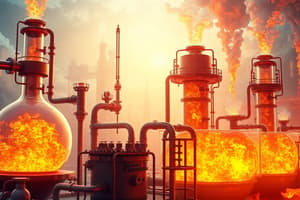Podcast
Questions and Answers
What conditions allow for a mixture to be separated into individual components using fractional distillation?
What conditions allow for a mixture to be separated into individual components using fractional distillation?
- The components must be miscible in water.
- The components must have the same melting point.
- The components must have different boiling points. (correct)
- The components must have equal vapor pressures.
What is the significance of the total vapor pressure (Ptot) in the process of distillation?
What is the significance of the total vapor pressure (Ptot) in the process of distillation?
- It must remain constant during the distillation process.
- It needs to be greater than the external pressure for boiling to occur. (correct)
- It should be equal to the sum of the vapor pressures of all components.
- It marks the threshold for the vaporization of all components.
In calculating the percentage composition of a vapor, what does the formula % A = (χA PA / Ptot) x 100% represent?
In calculating the percentage composition of a vapor, what does the formula % A = (χA PA / Ptot) x 100% represent?
- The ratio of the liquid component A to total liquid volume.
- The mass of component A in the mixture.
- The entire pressure of the vapor mixture.
- The fraction of component A in the vapor phase. (correct)
What happens to the composition of the liquid after a simple distillation, given that A is more volatile than B?
What happens to the composition of the liquid after a simple distillation, given that A is more volatile than B?
If the vapor pressure of compound A at boiling point is 1000 torr and compound B is 520 torr, what is the total vapor pressure when their mole fractions are both 0.5?
If the vapor pressure of compound A at boiling point is 1000 torr and compound B is 520 torr, what is the total vapor pressure when their mole fractions are both 0.5?
After performing a second simple distillation, how does the percentage composition of A change if it's assumed that PA is 900 torr?
After performing a second simple distillation, how does the percentage composition of A change if it's assumed that PA is 900 torr?
What is the likely outcome if sequential simple distillations are performed continuously on a mixture of A and B?
What is the likely outcome if sequential simple distillations are performed continuously on a mixture of A and B?
What characteristic of compounds A and B ensures effective separation during fractional distillation?
What characteristic of compounds A and B ensures effective separation during fractional distillation?
What is the role of the packing material in fractional distillation?
What is the role of the packing material in fractional distillation?
How is the height equivalent of theoretical plates (HETP) calculated?
How is the height equivalent of theoretical plates (HETP) calculated?
Which equation is used to calculate the total number of plates in the fractional distillation process?
Which equation is used to calculate the total number of plates in the fractional distillation process?
What is the relationship between nC and nT as determined by gas chromatography (GC)?
What is the relationship between nC and nT as determined by gas chromatography (GC)?
How is the number of plates in the packing material determined?
How is the number of plates in the packing material determined?
What is indicated by the presence of multiple theoretical plates in a fractional distillation column?
What is indicated by the presence of multiple theoretical plates in a fractional distillation column?
Why should open flames be avoided around volatile organics during the procedure?
Why should open flames be avoided around volatile organics during the procedure?
What is the purpose of collecting the first few drops during distillation?
What is the purpose of collecting the first few drops during distillation?
What is the main purpose of running all samples on gas chromatography (GC)?
What is the main purpose of running all samples on gas chromatography (GC)?
What should be done if the amount of liquid in the Hickman Head fills during distillation?
What should be done if the amount of liquid in the Hickman Head fills during distillation?
Study Notes
Fractional Distillation
- Separates liquids based on their boiling points
- Uses packing material in a column to increase surface area for condensation and vaporization
- More “simple distillations” occur, resulting in a more purified vapor
- Efficiency measured by HETP (Height Equivalent of Theoretical Plates)
- HETP calculated by dividing height of packing material by the number of theoretical plates
Gas Chromatography (GC)
- Separates gases based on their volatility
- Peak area on GC is proportional to the amount of material reaching the detector
- Can be used to determine the molar ratio of components in a mixture
- In this experiment, GC is used to determine the molar ratio of cyclohexane and toluene
Experimental Procedure
- Measure 4 mL of a 50/50 mixture of cyclohexane and toluene
- Add a stir bar to the mixture
- Assemble the distillation apparatus (round bottom flask, Vigreux column, Hickman head, water condenser, and thermometer)
- Heat the mixture in a sand bath to achieve a slow and steady boil
- Collect the first few drops of distillate (HETP fraction) and analyze by GC
- Continue distilling and collect 2 mL of distillate (fraction 1) and analyze by GC
- Analyze the remaining liquid in the round bottom flask (fraction 2) by GC
- Record the temperature range over which the distillate is collected
Calculating # of Theoretical Plates
- Use the molar ratio of cyclohexane (nC) to toluene (nT) determined by GC
- Calculate the total number of plates using the formula: Total # of plates = [log(nC /nT)/log2.33]
- Subtract 1 from the total number of plates to account for the glassware outside the column: # plates in packing material = total # of plates – 1
- Calculate the HETP using the formula: HETP = height of packing material (cm) / # of theoretical plates in packing material
Studying That Suits You
Use AI to generate personalized quizzes and flashcards to suit your learning preferences.
Description
This quiz covers the principles of fractional distillation and gas chromatography, including their methods and efficiencies. You'll understand how to separate liquids and gases based on physical properties and analyze mixtures. Test your knowledge on the experimental procedures involved in these techniques.




